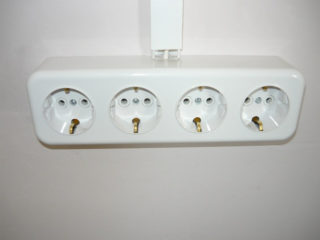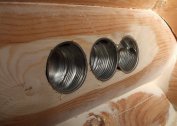A three-pole socket is used to expand the ability to connect electrical appliances in residential premises. With the help of a branching device, it is possible to increase the number of simultaneously switched loads to 3. Self-installation is possible only after familiarization with the design and with the existing classification of products of this class.
Three-pole receptacle device
Industrial products with three plugs are a popular product that is in great demand among the population. The main structural elements are:
- A case traditionally made on the basis of strong and resistant plastic materials.
- The back cover is made of the same plastic, which provides reliable protection of internal spaces from accidental contacts, as well as from dust, dirt and moisture.
- Three sets of linear copper busbars used as connecting and distributing conductors (phase, zero and ground).
The socket cover is fixed to the case with several pairs of reliable screw mounts suitable for a Phillips screwdriver. After its removal, access to all internal components of the product is opened, allowing you to directly connect it to an existing electrical network. The most important thing is to deal with the working buses to which the phase and neutral wires are connected, as well as with the terminals for connecting the protective grounding conductor.
Features and classification of single and bipolar products
Before you understand the features of installing a three-pole outlet, it is proposed to familiarize yourself with the classification of simpler analogs that have only one or two plug sockets.
Known samples of single and bipolar outlets differ in the following characteristic features:
- Used in the wiring of tires electrical circuit.
- Design features of execution.
- Degree of protection against moisture and dust (IP).
In accordance with the first sign, they are divided into bipolar sockets with a grounding contact (incorporating an additional bus) and 2-pin samples. The first are installed in circuits with 3-core wiring of the network cable, and the second only in two-wire lines in which the presence of the third core is not provided for by the features of the cable entry. This type of wiring is most often found in apartment buildings of the old buildings, where the input cable has only two wires (phase and zero).
According to their design features, all products of this class are divided into sockets that are openly mounted on the walls of the apartment and into socket modules installed in special niches. They are suitable for the appropriate type of electrical cable routing (external and hidden). According to the degree of protection, all these products are divided into several groups, each of which corresponds to a certain level of tightness of the case.
When choosing this indicator, you should decide on where the apartment or private house is supposed to use the purchased model. If it is intended for installation in rooms with a high level of humidity (in bathrooms, showers or in the kitchen), it is necessary to choose a socket with a high level of protection, not less than IP55. A similar approach to choosing a product will be required when installing it in rooms with a high level of dust (in the attic or in the basement of a private house).
The modern bipolar socket in the external version can be equipped with a special protective cover and LED backlight. In cases of more expensive and "advanced" models, a shutdown timer is sometimes built in. With hidden wiring, recessed type products are installed. They are placed in a plastic mounting box, and the lead-in wires are tightly walled up in the walls.
Self-assembly
Before installing any type of outlets yourself, you will need to familiarize yourself with the basic methods for installing them, corresponding to the two options for laying the lead wires.
Outdoor way
Three-pole plug socket, designed for outdoor installation, is mounted directly on the room wall or on a special socket, fixed on the wall surface. Connecting wires are led to it along the same plane and placed in a plastic cable channel, from which the protective cover is previously removed. After laying a bundle of conductors in it, the latter are brought to the socket housing and connected to the corresponding contacts.
To connect the wires to the terminals (sockets), the socket cover must be removed from the housing. Upon completion of installation operations, the product is completely assembled, the covers of the cable channels return to their place.
Recessed version
When a recessed outlet is installed, a niche in the wall is prepared for it, in shape corresponding to the contours of the mounting box. To select the wall material, you will need a special tool called a stroborez. If such a device is not available in the household, an ordinary grinder can be used for grooving.
In the wall in the installation area along the longitudinal axis, several strobes are cut, which are aligned with a chisel in the shape of a rectangle of the desired size. Subsequent operations:
- An installation box is walled up in the finished longitudinal niche.
- To the outlet with the rear cover removed, the lead wires laid in the strobes are connected.
- At the final stage of work, the lid is returned to its place, fastened in the mounting box by means of spacer screws.
Then it remains to block the sections of walls with lead wires and close the outlet on the outside with a decorative panel.
Choosing the right product

When choosing a suitable sample, you will need to carefully read the technical specifications of the outlets offered in the store. In this case, it is necessary to proceed from the following indicators:
- main dimensions: length, width and depth;
- number of poles: one, two or three;
- mounting method: open or recessed options;
- the presence of a grounding contact and additional accessories: LED indicator for mains power, for example;
- fixing method of lead wires: for soldering or for fixing screw.
The model is selected taking into account technical parameters that fully comply with the user's needs.








